Japanese Drops: Kimono
| 3 Febbraio 2010 | 7 comments |
|
Tweet |
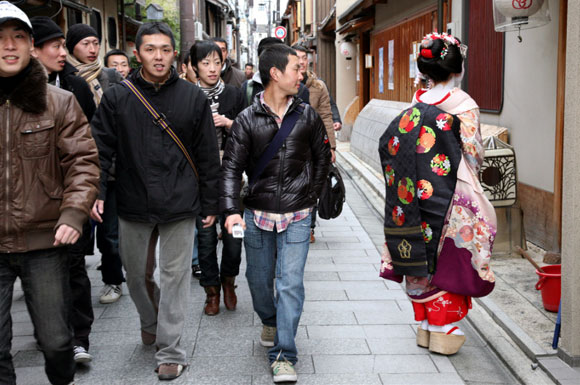
Kyoto, tradizione e modernità / Kyoto, the modern and the traditional © Melissa Rose Chasse
Kimono 着物 significa letteralmente “cosa che si indossa” da “ki” che significa “indossare” e “mono” che significa “cosa”. In passato per kimono si intendeva qualsiasi tipo di abito, in seguito col passare del tempo, dal diciannovesimo secolo si è rafforzata l’idea di chiamare kimono solamente il capo tradizionale che conosciamo oggi, in contrapposizione all’abito occidentale, lo yōfuku.
In Giappone si può scegliere indifferentemente di vestirsi all’occidentale o con il classico abbigliamento tradizionale, sia per le occasioni formali che per quelle informali, anche se per l’abbigliamento di tutti i giorni si preferiscono per praticità gli abiti occidentali, si può tuttavia affermare che esiste una duplice tipologia di vestiario, senza abbandonare l’uso del kimono.
Kimono 着物 literally means “thing to wear” from “ki” which means “wear” and “mono” which means “thing”. In the past kimono were any article of clothing, then as time goes, from the nineteenth century, it was reinforced the idea of calling kimono only the traditional item that we know today, as opposed to Western dress, the yōfuku.
In Japan people can choose to dress in classic Western or traditional clothing likewise, for both formal and informal occasions, even though for everyday clothing Western dresses are preferred for convenience, it can be said that there is a double type of clothing, without abandoning the use of the kimono.
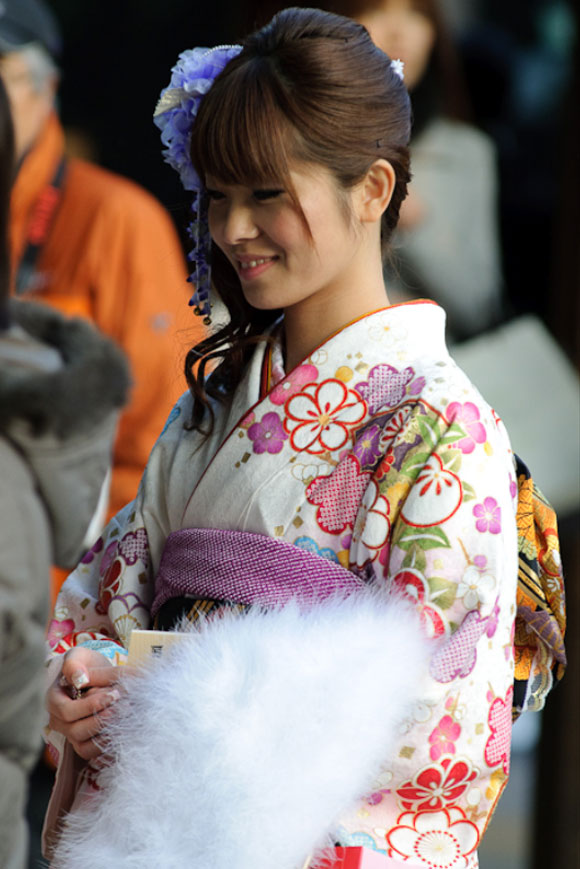
Meiji Jingu, Tokyo, una ragazza kawaii con kimono / Meiji Jingu, Tokyo, a kawaii girl wearing kimono
© Gideon Davidson
- Realizzazione e cura / Design and care
I kimono vengono realizzati da un solo rotolo di tessuto, chiamato “tan” della dimensione tradizionale di 35 cm per 11 m, dal quale si ricavano due strisce di tessuto per la parte anteriore, due per la parte posteriore e due strisce più strette per il colletto e i risvolti.
Il metodo più antico per lavare il kimono è chimato “arai hari” e consiste nello scucirne le parti per poi ricucirlo una volta asciutto. Oggi questa pratica è molto meno usata, se non per i kimono antichi e più costosi, anche grazie ai nuovi metodi di lavaggio e ai tessuti moderni.
I kimono dopo essere stati accuratamente piegati con dei metodi precisi per evitare il formarsi di grinze, vengono conservati avvolti da uno speciale tipo di carta chiamato “tatōshi”.
The kimono are made from a single bolt of fabric, called “tan” in the traditional dimensions of 35 cm (14 inches) by 11 m (12½ yards), by which are cut two strips of fabric for the front, two for the back and two narrower stripes for the collar and lapels.
The oldest method to wash the kimono is “arai hari” and consist in unstitch the parts and then sew it again when is dry. Today this practice is much less used, except for antique kimono and more expensive ones, thanks to new methods of washing and modern fabrics.
The kimono, after being carefully folded with precise methods to prevent formation of creases, are kept wrapped in a special type of paper called “tatōshi”.

Meiji Jingu, Tokyo, giovane coppia kawaii in kimono
Meiji Jingu, Tokyo, young kawaii couple wearing kimono © Gideon Davidson
- Taglia / Size
I kimono per gli adulti, e specialmente per le donne, hanno tutti la stessa taglia, la lunghezza si regola “rimborsando” l’eccesso sotto l’obi.
In passato quando il kimono era tagliato esclusivamente dal tan di misura tradizionale, le persone di grossa taglia, come i lottatori di sumo, dovevano ricorrere ai kimono su misura, molto più costosi dei formati standard.
The kimono for adults, and especially for women, have the same size, the length is adjusted by ”hiding” the excess under the obi.
In the past when the kimono was cut only from the tan in the traditional measure, extra-large people, such as sumo wrestlers, had to buy custom-made kimono, much more expensive than standard sizes.

Miyagawa-cho, Kyoto, una famosa maiko / Miyagawa-cho, Kyoto, a popular maiko
© Melissa Rose Chasse
- Tessuto / Textile
Tradizionalmente il kimono è in seta, crêpe di seta (come il “chirimen”), broccato di seta o satinato (come il “rinzu”) non solo perchè è il tessuto più pregiato, ma anche per retaggio culturale.
Attualmente i kimono si possono acquistare anche in altri tessuti più facili da lavare, meno costosi ed informali, come in cotone, poliestere e rayon, ma nelle occasioni ufficiali e formali e d’obbligo il kimono in seta.
Traditionally, the kimono is made of silk, silk crepes (such as “chirimen”), silk brocade, and satin weaves (such as “rinzu”) silk, not only because it is the finest fabric, but also for cultural heritage.
Currently, the kimono can be purchased in other fabrics that are easier to clean, less expensive and informal, as cotton, polyester and rayon, but on state and formal occasions silk kimono are required.
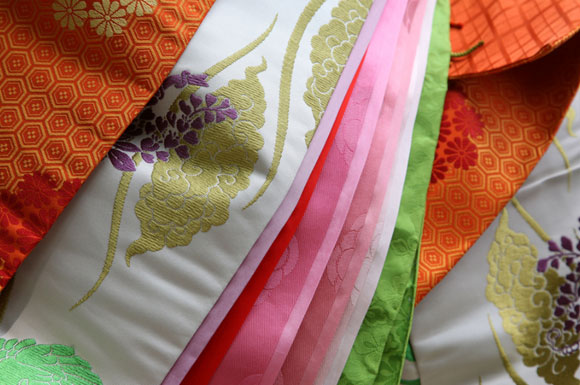
Junihitoe: uno scorcio dei 12 strati di vesti che indossavano le cortigiane del periodo Heian /
Junihitoe: a few of the 12 layered robes worn by the Heian period courtiers © Melissa Rose Chasse
- Decorazione / Decoration
Il kimono oltre ad essere per tradizione cucito a mano, viene anche dipinto a mano usando diverse tecniche a seconda del risultato che si desidera ottenere e dal tipo di disegno.
Citiamo lo yuzen, una tecnica di tintura a mano libera con l’ausilio anche di amido di riso o colla, lo shibori, una tecnica che consiste nel legare il tessuto per poi intingerlo nel colore, ottenendo così delle variazioni di tonalità in prossimità dei nodi, infine la tradizionale pittura a mano e a stencil.
Nei kimono sono molto importanti le decorazioni che, insieme al tipo di tessuto e modello, ne determinano la formalità o informalità. Le decorazioni devono rispecchiare la stagione in cui lo si indossa, per esempio un paesaggio innevato si presterà all’inverno, mentre i fiori di ciliegio alla primavera.
Poichè non tutti i giapponesi possono permettersi numerosi kimono nel loro corredo, poichè i prezzi sono molto alti, si può ovviare al decoro acquistando dei kimono che raffigurino tutte le stagioni o soggetti neutri, come i ventagli, o astratti, per essere adatti così ad ogni periodo dell’anno.
I kimono maschili sono solitamente in tinta unita o con un leggero decoro e hanno colori sobri e scuri.
The kimono as well as being traditionally hand-sewn, is also painted by hand using various techniques depending on the result to get and the type of design.
These include the yuzen, a technique of dyeing freehand also using rice starch or glue, the shibori, a technique which consists in tying a textile and then dip it in color, resulting some changes of tone where there were the nodes, at last the traditional hand painting and stencil.
In kimono are very important the decorations that along with the type of fabric and model, determine the formality or informality. The decorations should reflect the season in which kimono is worn, such as a snowy landscape will be appropriate for winter, while the cherry blossoms for spring.
Since not every Japanese can afford many kimono, because the prices are very high, it can compensate for the decoration by buying kimono that represent all seasons or neutral subjects, such as fans, or abstract, to be always appropriate.
The male kimono are usually plain or with a light decor and the colors are sober and dark.

Ragazze che indossano un kimono furisode / Girls wearing furisode kimono © Gideon Davidson
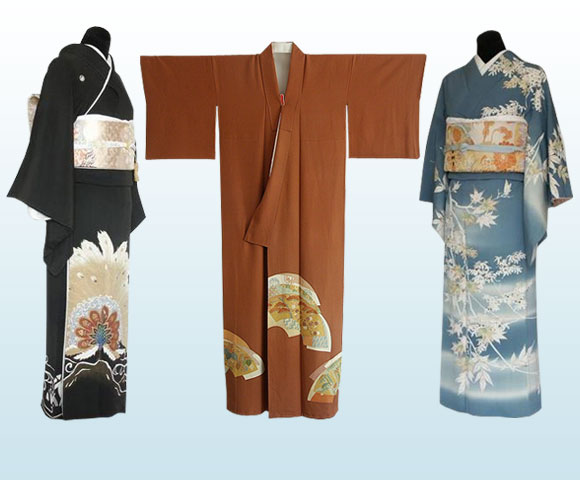
Da sinistra a destra / From the left to the right:
kurotomesode kimono, irotomesode kimono, homongi kimono

Da sinistra a destra / From the left to the right: tsukesage kimono, komon kimono, mofuku kimono
Sullo sfondo / In the background: edo komon kimono texture

Kimono, tre membri della Associazione Gion Tea Ceremony indossano un kimono iromuji
Kyoto, members of the Gion Tea Ceremony Association, wearing iromuji kimono © Melissa Rose Chasse
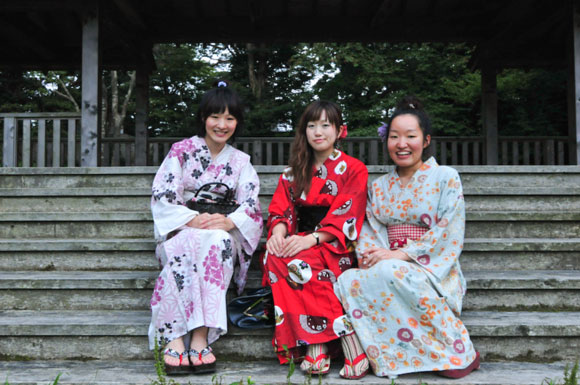
Tohoku, Ragazze che indossano un kimono yukata / Tohoku, Girls wearing yukata kimono
© Gideon Davidson

Kyoto, matrimonio scintoista al tempio Itsukushima, la sposa indossa un kimono uchikake
Kyoto, Shinto wedding at Itsukushima Shrine, the bride wears a uchikake kimono
© Melissa Rose Chasse

Danza annuale primaverile, Kyoto, una geisha indossa un kimono susohiki
Annual spring dance, Kyoto, geisha wearing a susohiki kimono © Melissa Rose Chasse
- Tipi di Kimono / Kind of Kimono
Esistono diversi tipi di kimono da indossare a seconda della circostanza e dell’età:
- Furisode (振袖): sono gli scenografici kimono ricchi di decorazioni a maniche lunghe, adatti per le donne nubili e giovani soprattutto nelle occasioni formali.
- Kurotomesode (黒留袖): kimono nero formale per le donne sposate, con decoro sotto l’obi e solitamente decorato con cinque kamon (stemma di famiglia).
- Irotomesode (色留袖): kimono a tinta unita per le donne sposate, decorato sotto la cintura, può essere decorato con tre o cinque kamon, è meno formale del kurotomesode.
- Hōmongi (訪問着): kimono per donne nubili o sposate, ha decorazioni anche sulla parte superiore e sulle maniche, è utilizzato per le occasioni formali.
- Tsukesage (付け下げ): kimono per donne nubili o sposate, ha decorazioni sotto l’obi ed è meno formale dell’hōmongi.
- Iromuji (色無地): kimono per donne nubili o sposate, è a tinta unita e gioca sulle decorazioni tono su tono, vengono indossati soprattutto durante le cerimonie del tè.
- Komon (小紋): kimono informale per donne nubili o sposate, è caratterizzato da un motivo che si ripete per tutto il tessuto.
- Edo Komon (江戸小紋): tipo di komon decorato con dei punti che creano dei motivi sul tessuto, più formale del classico Komon e se dipinto con i kamon acquisisce maggiore formalità.
- Yukata (浴衣): kimono leggero sia per uomini che per donne di ogni età, è informale e tessuto in cotone, lino o canapa. Spesso vengono anche offerti agli ospiti degli stabilimenti termali.
- Uchikake: è un kimono da sposa o usato in teatro, è molto formale, riccamente decorato e ha il bordo inferiore imbottito per formare uno strascico che ricade a terra in modo grazioso. Non viene chiuso con l’obi e viene indossato sopra il kimono da sposa, solitamente un furisode.
- Susohiki / Hikizuri: è un kimono molto elegante che va portato lungo, con lo strascico imbottito che tocca terra ed è usato dalle geisha, maiko o dalle artiste sul palco.
- Mofuku: è un kimono formale completamente nero con cinque kamon, viene indossato durante i funerali.
There are different types of kimono worn depending on the circumstances and age:
- Furisode (振袖): are the spectacular kimono adorned with long sleeves, suitable for single and young women especially in formal occasions.
- Kurotomesode (黒留袖): black formal kimono for married women, with decoration under the obi and usually decorated with five kamon (family crest).
- Irotomesode (色留袖): plain kimono for married women, decorated under its belt, can be decorated with three or five kamon, is less formal kurotomesode.
- Hōmongi (访问着): kimono for single or married women, has also decorations on the top and on the sleeves, is used for formal occasions.
- Tsukesage (付け下げ): kimono for single or married women, is decorated under the obi and is less formal than hōmongi.
- Iromuji (色无地): kimono for single or married women, is plain and has decoration tone on tone, is worn especially during the tea ceremonies.
- Komon (小纹): informal kimono for single or married women, is characterized by a pattern that is repeated throughout the fabric.
- Edo Komon (江戸小纹): type of komon decorated with dots that create designes on the fabric, more formal than the classic komon, if it is decorated with kamon is more formal.
- Yukata (浴衣): light kimono for both men and women of all ages, is an informal cotton, linen or hemp clothing. It is often offered to guests of the spa.
- Uchikake: is a wedding kimono or used on stage, it is very formal, richly decorated and has a padded bottom edge to fall to the ground gracefully. It is not closed with the obi and is worn over the kimono, usually a furisode.
- Susohiki / Hikizuri: is a very elegant long kimono, padded with a train that touches the ground and is used by geisha, maiko, or the artists on stage.
- Mofuku: is a formal black kimono with five kamon, worn at funerals.

Kyoto, due maiko che indossano un haori / Kyoto, Two maiko wearing a haori © Melissa Rose Chasse

Kyoto, una maiko solleva il suo kimono susohiki e mostra il suo hiyoku
Kyoto, a maiko raises her susohiki kimono and shows her hiyoku © Melissa Rose Chasse

Kyoto, una geisha indossa i kanzashi / Kyoto, a geisha wears kanzashi © Melissa Rose Chasse

Kyoto, una maiko indossa i kanzashi / Kyoto, a maiko wears kanzashi © Melissa Rose Chasse

Kyoto, due maiko indossano i kanzashi / Kyoto, two maiko wear kanzashi © Melissa Rose Chasse
- Accessori per Kimono / Accessories for Kimono
- Nagajuban (長襦袢, o juban): usato sia da uomini che da donne, è un sotto-kimono che serve per evitare il contatto diretto tra la pelle e il kimono, in modo che il kimono rimanga pulito. L’unica parte visibile del nagajuban è il colletto, che si può staccare e sostituire per coordinarlo al colore del kimono.
- Hadajuban (肌襦袢): usato sia da uomini che da donne, va indossato sotto il nagajuban ed è paragonabile ad una canottiera.
- Susoyoke (裾除け): indossato dalle donne è una sottogonna da portare sotto il nagajuban.
- Kimono Slip (着物スリップ): unione di susoyoke e hadajuban.
- Eri-Sugata (衿姿): colletto da indossare al posto dell’intero nagajuban nella stagione estiva.
- Hakama (袴): è una sorta di gonna-pantalone indossata originariamente solo dagli uomini, ma in seguito anche dalle donne in occasioni meno formali, durante la laurea o dalle sacerdotesse. Vengono usati anche come uniforme per alcuni sport, come l’aikido o il kendo.
- Haori (羽織): è una giacca-kimono formale originariamente usata solo dagli uomini, in seguito estesa anche alle donne.
- Haori-himo (羽織紐): è la cintura per l’haori.
- Happi (法被): è uno speciale tipo di haori, usato per lo più durante le feste.
- Hanten (袢纏): è una versione più informale e imbottita dell’haori.
- Hiyoku (ひよく): indossato dalle donne, è un sotto-kimono molto formale usato per eventi importanti.
- Kanzashi (簪): sono i tradizionali ornamenti femminili per capelli da indossare insieme al kimono.
- Samue (作務衣): è l’abbigliamento quotidiano usato dai monaci buddisti, composto da una giacca-kimono e dei pantaloni.
- FundoshI (褌): è il tradizionale perizoma maschile.
- Nagajuban (长襦袢 or Juban): used by both men and women, is a under-kimono used to avoid the direct contact between the skin and the kimono, to keep it clean. The only visible part of nagajuban is the collar, which can be removed and replaced to co-ordinate the color of the kimono.
- Hadajuban (肌襦袢): used by both men and women, is worn under the nagajuban and is comparable to a vest.
- Susoyoke (裾除け) worn by women is a petticoat to wear under nagajuban.
- Kimono Slip (着物スリップ): a merger between susoyoke and hadajuban.
- Eri-Sugata (衿姿) collar to wear instead of the entire nagajuban in summer.
- Hakama (袴) is a kind of skirt originally worn only by men, but later also by women in less formal occasions, during graduation or in shinto shrines by shaman woman. It is also used as a uniform for some sports, such as aikido or kendo.
- Haori (羽织) is a formal kimono-jacket originally used only by men, later extended to women.
- Haori-himo (羽织纽): is the belt for haori.
- Happi (法被) is a special type of haori, used mostly during the festivals.
- Hanten (袢缠) is a padded and more informal version of haori.
- Hiyoku (ひよく) worn by women, is a very formal under-kimono used for important events.
- Kanzashi (簪): are the traditional female hair ornaments worn with the kimono.
- Samui (作务衣) is the everyday clothing used by Buddhist monks, consisting of a kimono-jacket and pants.
- Fundoshi (褌) is the traditional male underwear or loin-cloth.

Kyoto, due maiko con i loro lunghi obi / Kyoto, two maiko with their long obi © Melissa Rose Chasse

Meiji Jingu, Tokyo, tre ragazze in kimono/ Meiji Jingu, Tokyo, tree girls with kimono © Gideon Davidson
- Obi e i suoi accessori / Obi and its Accessories
- Obi (帯): è la fascia, tradizionalmente di seta, che serve per fermare e adornare il kimono in vita. Indossata con differenze nei colori, nella lunghezza, nella forma del nodo e nella posizione (più in alto o in basso rispetto alla vita) a seconda che la indossi un uomo o una donna o a seconda dell’età.
- Obi-ita (帯板 o mae-ita): è una specie di tavoletta indossato dalle donne sotto l’obi per tenere il kimono in posizione.
- Obiage (帯揚げ): è una fascia annodata nella parte superiore dell’obi che copre l’obimakura e serve per tenere in posizione l’obi. A seconda dell’età può essere più o meno visibile (più evidente nelle ragazze, più nascosto con l’avanzare dell’età) e deve essere coordinato nei colori con il kimono e l’obi.
- Obimakura (帯枕): una sorta di cuscino di applicare nella parte posteriore dell’obi per dare volume al nodo.
- Obijime (帯締め): è la corda che si lega attorno all’obi.
- Datejime or Datemaki (伊達締め), Koshihimo or Karihimo (腰紐): fasce che servono per tenere il kimono in posizione prima di indossare l’obi.
- Netsuke: è un oggetto ornamentale abbinato all’obi.
- Obi (帯): is the band, traditionally made of silk, which serves to fasten and adorn the kimono at the waist. Worn by differences in color, length, form of the knot and the position (higher or lower relative to waist) depending on depending on who wears it is a man or a woman or according to age.
- Obi-ita (帯 板 or mae-eng) is a kind of tablet worn by women under the obi to keep the kimono in place.
- Obiage (帯揚げ) is a belt tied at the top ot the obi that covers the obimakura and serves to keep in place the obi. Depending on the age may be more or less visible (more evident in girls, more hidden in adults) and it has to be coordinated in color with the kimono and the obi.
- Obimakura (帯枕): a sort of pillow to apply in the bottom of the obi to give volume to the knot.
- Obijime (帯締め): it is the rope that is tied around the obi.
- Datejime or Datemaki (伊達締め) Koshihimo or Karihimo (腰纽) bands that serve to keep kimono in place before wearing the obi.
- Netsuke: is an ornament matched with obi.

Kyoto, una geisha con i suoi geta e tabi / Kyoto, a geisha with her geta and tabi © Melissa Rose Chasse

Kyoto, tre ragazze con kimono e zōri / Kyoto, three girls with kimono e zōri © Melissa Rose Chasse
- Le Calzature / The Footwear
- Tabi (足袋): sono delle calze inamidate che arrivano alla caviglia, con un divisorio tra l’alluce e il secondo dito. Vengono indossate con gli zōri o i geta.
- Geta (下駄): indossati da uomini e donne con lo yukata, sono i sandali infradito di legno tradizionali. Quelli delle geisha sono più alti.
- Zōri (草履): simili alle infradito occidentali, possono essere di pelle, stoffa o paglia.
- Waraji (草鞋): sono sandali di corda e paglia indossati solitamente dai monaci.
- Tabi (足袋) are starched socks at the ankle, with a divider between the big toe and the second toe. They are worn with the zōri or the geta.
- Geta (下駄) worn by men and women with the yukata, are the traditional wooden flip-flop. The geisha ones are higher.
- Zōri (草履): similar to Western flip-flop, can be made of leather, fabric or straw.
- Waraji (草鞋): straw sandals usually worn by monks.

Una bambina che indossa un kimono / A little girl wearing kimono © Gideon Davidson
Fonti / Via
Flickr - Melissa Rose Chasse
Flickr - Gideon Davidson
| Angela & Laura |
|
|
|
|
Similar Posts:
- Japanese Drops: Kimono Dressing
- The Dreamlike Kanzashi by Sakae
- Japanese Drops: Lolita Style ♥ Part 2
- Japanese Drops: Yayoi Kusama ♥ Part 1
- Japanese Drops: Yuki Onna, the Snow Woman

|
Tags: handmade, Japan, Japanese Drops, textile |


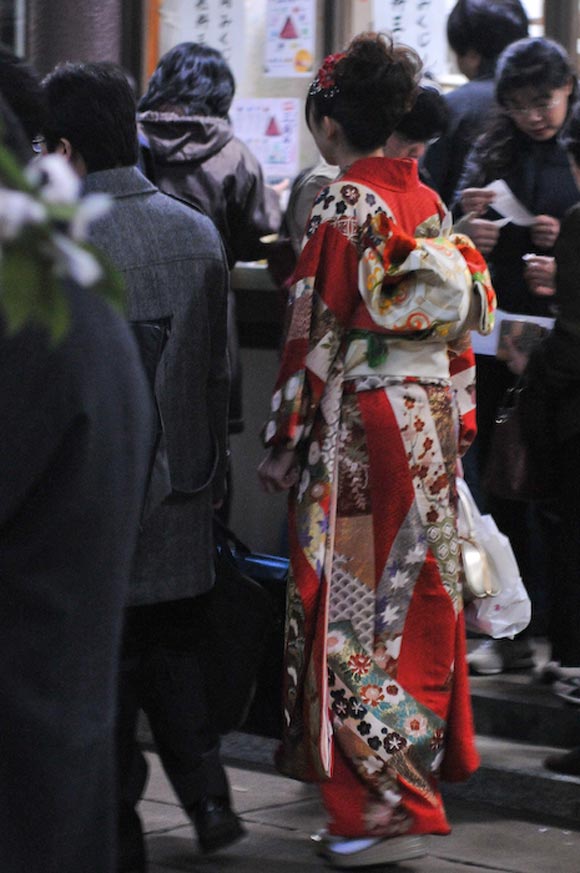











These kimonos are so beautiful! I love this article, great explanation!
The flowers in the geisha’s hair (kanzashi, right?) are wonderful! (*O*)
I really love your blog :) i visit it every day!!
<3
@Yokohama
Kanzashi are amazing, my favourite are fuji kanzashi (wisteria one), but also sakura (cherry) kanzashi ^___^
I would like to get one >___<
@Duju
Thanks!!! :°)
@Yokohama and Duju
… you make me happy >.<
Todo el tiempo me han encantado ver a las japonesas vistiendo sus kimonos, el Japon es uno de los lugares mas bellos del mundo, empezando por sus árboles de cerezo, me facinan.
Interessanti informazioni per tutti gli amanti delle geishe e dei kimono come me ^_^.
Io sto facendo una ricerca per la scuola dove dovrò disegnare le geishe,i loro kimono e accessori e gli eventi in cui danno spettacolo o a cui partecipano… un lavorone.. più cerco informazioni più mi rendo conto di quanto sia complesso solo il mondo delle geishe, figuriamoci del giappone intero! (e il prof che mi fa “Dai, perchè non mi parli del giappone intero intorno all ottocento!” o_O nooo!!)
@Silvia
Spero proprio che tu riesca a far rinsavire la tua professoressa, che evidentemente non si rende conto della vastità dell’argomento!
Mi sembra che già una ricerca a tutto tondo sulla geisha sia già un lavorone imponente, ci sono saggi interi solo sull’argomento!
In bocca al lupo! ^___^
Commenta! ♥ Comment!
Categorie ♥ Categories
Autori ♥ Authors
Tag Cloud
WP Cumulus Flash tag cloud by Roy Tanck requires Flash Player 9 or better.
Archivio ♥ Archive
Link